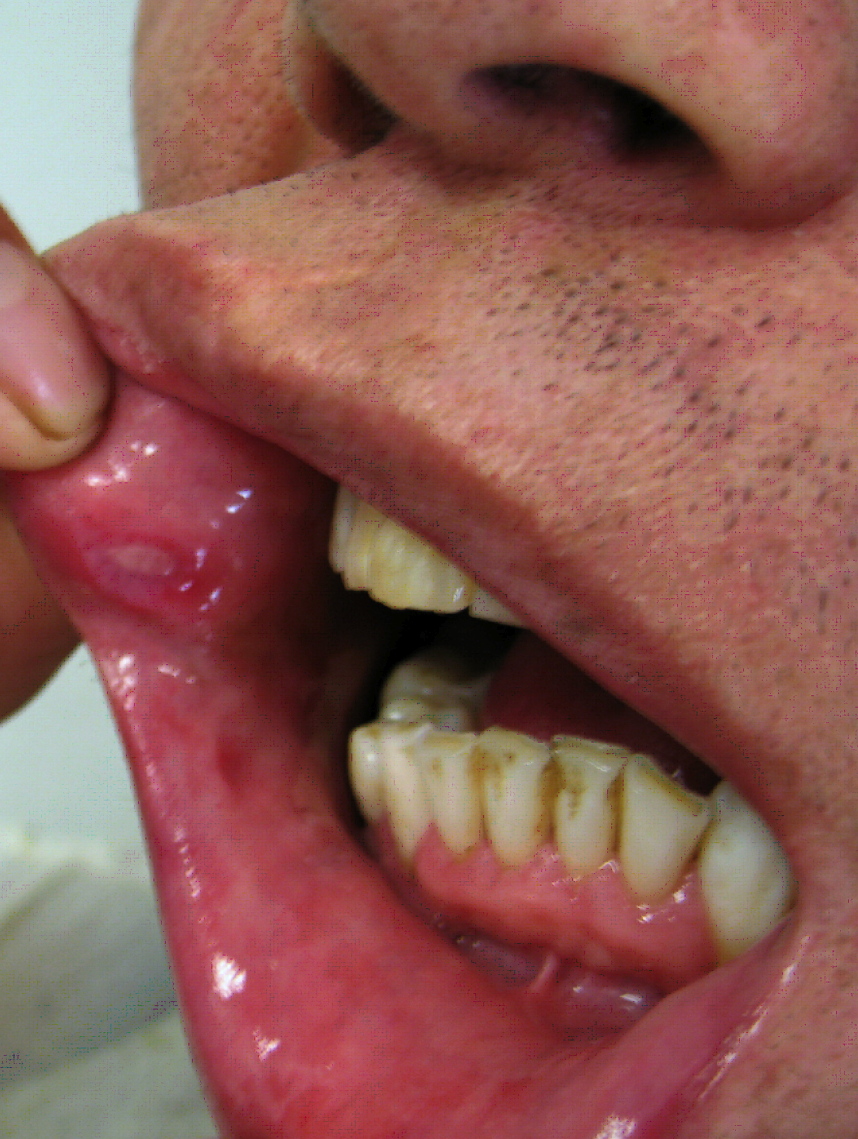WBR0602
| Author | [[PageAuthor::Ayokunle Olubaniyi, M.B,B.S [1]]] |
|---|---|
| Exam Type | ExamType::USMLE Step 2 CK |
| Main Category | MainCategory::Internal medicine |
| Sub Category | SubCategory::Allergy/Immunology |
| Prompt | [[Prompt::A 35 year old Turkish male was admitted with painful redness in the conjunctiva and acutely blurred vision in his right eye. He had a history of recurrent buccal aphthosis and diarrhea associated with moderate abdominal pain. At admission, decreased visual acuity in the right eye (20/200) was observed. Fundus examination revealed a right hyperemic disc with blurred margins. Laboratory studies were normal except an increased ESR (erythrocyte sedimentation rate, 33 mm/1 h). A pathergy test done was positive. Examination of the mouth revealed a lesion shown in the image below.
Which of the following is the diagnosis in this man?]] |
| Answer A | AnswerA::Systemic lupus erythematosus |
| Answer A Explanation | [[AnswerAExp::Incorrect. Systemic lupus erythematosus is a systemic autoimmune disorder that can affect any part of the body. It commonly affects the heart, joints, skin, lungs, blood vessels, liver, kidneys, and nervous system. Features include a characteristic malar rash, photosensitivity, arthritis, Immunological tests reveals a positive anti-Smith, anti-ds DNA, antiphospholipid antibody, and/or false positive serological test for syphilis. Treatment involves the use of corticosteroids, antimalarials, and immunosuppressants.]] |
| Answer B | AnswerB::Inflammatory bowel disease |
| Answer B Explanation | [[AnswerBExp::Incorrect. Inflammatory bowel disease is a group of inflammatory conditions affecting mainly the colon and the small intestine. The major types of IBD are Crohn's disease and ulcerative colitis. Symptoms include: abdominal pain, vomiting, diarrhea, rectal bleeding, severe internal cramps/muscle spasms in the region of the pelvis and weight loss. Anemia is the most prevalent extra-intestinal complication of inflammatory bowel disease. Other extra-intestinal manifestations include: arthritis, pyoderma gangrenosum, primary sclerosing cholangitis, and non-thyroidal illness syndrome (NTIS).
Diagnosis is generally by assessment of inflammatory markers in stool followed by colonoscopy with biopsy of pathological lesions. Treatment is with mesalazine, prednisone, TNF inhibitors (e.g., etanercept), azathioprine, methotrexate, or 6-mercaptopurine.]] |
| Answer C | AnswerC::Behçet's disease |
| Answer C Explanation | [[AnswerCExp::Correct. Behçet's disease a.k.a. Behçet's syndrome is a chronic multi-systemic vasculitis characterized by mucocutaneous, articular, neurological, gastrointestinal and ocular lesions. It involves a triad of symptoms that include recurring mouth ulcers (aphthous ulcers, canker sores), genital ulcers, and uveitis.]] |
| Answer D | AnswerD::Antiphopholipid syndrome |
| Answer D Explanation | [[AnswerDExp::Incorrect. Antiphopholipid syndrome is an autoimmune disease in which "antiphospholipid antibodies" (anti-cardiolipin antibodies and lupus anticoagulant) react against proteins that bind to anionic phospholipids on plasma membranes. Common manifestation include: recurrent venous or arterial thrombosis and/or fetal loss.]] |
| Answer E | AnswerE::Amyloidosis |
| Answer E Explanation | [[AnswerEExp::Incorrect. Amyloidosis is a group of diseases resulting from abnormal deposition of amyloid protein in various tissues of the body. Amyloidosis can be systemic or organ specific. It could affect all the organs in the body. Symptoms depend on the organs affected by the deposits. These organs can include the tongue, intestines, skeletal and smooth muscles, nerves, skin, ligaments, heart, liver, spleen, and kidneys.]] |
| Right Answer | RightAnswer::C |
| Explanation | [[Explanation::Behçet's disease a.k.a. Behçet's syndrome is a chronic multi-systemic vasculitis characterized by mucocutaneous, articular, neurological, gastrointestinal and ocular lesions. It involves a triad of symptoms that include recurring mouth ulcers (aphthous ulcers, canker sores), genital ulcers, and uveitis. Other ocular manifestations include iridocyclitis, retinal and choroidal vasculitis, optic neuritis and retinal vascular occlusion. It is common among Turkey, Asia and Middle-east population, and usually affects people in the 2nd and third decade of life.
The underlying pathology is caused by an overactive immune system without an apparent infection. It is diagnosed according to the International Study Group diagnostic guidelines: The presence of oral (aphthous) ulcers (any shape, size or number at least 3 times in any 12 months) plus 2 out of the next 4 "hallmark" symptoms: - Genital ulcers (including anal ulcers and spots in the genital region and swollen testicles or epididymitis in men), - Skin lesions (papulo-pustules, folliculitis, erythema nodosum, acne in post-adolescents not on corticosteroids), - Eye inflammation (iritis, uveitis, retinal vasculitis, cells in the vitreous), - Pathergy reaction (papule >2 mm dia. 24-48 hrs or more after needle-prick) The current treatment is aimed at reducing the symptoms. Anti-inflammatory agents such as infliximab, etanercept which are anti-TNF agents and other drugs like interferon alfa-2a, azathioprine, colchicine, thalidomide, dapsone and rebamipide are useful alternatives. Educational Objective: A history of recurrent mouth ulcers (aphthous ulcers, canker sores), genital ulcers, and uveitis is highly suggestive of Behçet's disease which is common among the Turkish, Asian, and middle-east population. It is a multi-systemic inflammatory disorder, and treated with anti-inflammatory agents and immunosuppressants. |
| Approved | Approved::No |
| Keyword | WBRKeyword::Behçet's disease, WBRKeyword::Behçet's syndrome, WBRKeyword::Behcet's syndrome, WBRKeyword::inflammatory vasculitis |
| Linked Question | Linked:: |
| Order in Linked Questions | LinkedOrder:: |
